| Where have the Au Sable River trout gone? from The Fishing Wire Spring ushered into northern Michigan an unwelcomed guest in 2018…an extended winter with an unprecedented snowfall in April. When winter finally relented, and anglers were able to get out and enjoy fishing their favorite spots, the DNR Fisheries Division’s Northern Lake Huron Management Unit started getting phone calls from concerned anglers about their lack of success on the North Branch of the Au Sable River. The unit receives “there are no fish in my lake” calls on a regular basis, and usually they are based on an angler’s couple of days of poor fishing. This year on the North Branch, however, staff were getting calls from professional trout fishing guides who had never complained about the fishing before. They told local staff they were experiencing extremely low catch rates and weren’t seeing the feeding activity they normally would during insect hatches.The North Branch was scheduled for Fisheries Division to conduct population estimates in the late summer at three different sites. However, with the number of anglers reporting startlingly low catch rates of trout, the division decided to conduct electrofishing spot checks on May 30. To build on the strong partnership in the Au Sable River, Fisheries Division invited several of the guides who informed the department to come and help conduct the electrofishing efforts. The first round of electrofishing spot checks were at places that are surveyed regularly. Shortly after the survey started, it was readily apparent the trout population was down from levels normally seen in late summer. “Most anglers understand that trout can move fairly large distances, usually seasonally, so making direct comparisons of the survey results occurring at different times of the year should be avoided,” said the Northern Lake Huron Management Unit manager, Dave Borgeson. “Regardless, the decline in the number of fish surveyed at the sites corroborated the angler reports so we decided to conduct four more spot checks at other locations on June 7, and got similar results. “For some unknown reason, it became clear the trout population in the North Branch had declined from the previous year. There was a lot of head-scratching and hypothesis-sharing regarding the cause of the apparent decline, and some of the angler’s ideas centered on the possibility of mortality due to toxic substances introduced into the stream. While trout populations can vary widely from year to year for a variety of reasons, Fisheries Division decided to notify the Michigan Department of Environmental Quality of the angler’s observations and the electrofishing results. A working group of concerned anglers, DEQ staff, and Fisheries Division employees Neal Godby and Borgeson teamed up to discuss the status of the stream and plan a strategy for additional information gathering in 2018.The DEQ planned to do some water chemistry work and conduct aquatic invertebrate sampling in the North Branch, Fisheries Division would conduct trout population estimates at three stations on the river, and the angling groups planned to do their annual quantitative aquatic invertebrate sampling as well as cooperate with the U.S. Geological Survey (USGS) to conduct a contaminant survey using lipid-based collection gear deployed in the stream. The DEQ’s Water Resource Division conducted three P51 Habitat and Macroinvertebrate surveys in mid-June and found “All three sites surveyed in June 2018 scored excellent for both habitat and macroinvertebrates. All sites had excellent macroinvertebrate diversity with 37 taxa found at Dam Four, 32 at Twin Bridge Rd., and 31 at the Ford. Of these, 20 taxa at Dam Four, 18 taxa at Twin Bridges, and 15 taxa at the Ford were ephemeroptera, plecoptera, or tricoptera (EPT) taxa indicating excellent water quality. “The USGS organic chemical sampling results are pending. Fisheries Division electrofishing surveys revealed: At Twin Bridges the brook trout density and biomass were at the lowest recorded level in the past 30 years, and brown trout density and biomass levels were on par with the past two years. At Eamon’s Landing the brook trout density was around the long-term average and biomass was on par with the past two years (but low compared with the long-term average). At Dam 4 the brook trout density was well below average and biomass was at its lowest recorded level in the last 30 years. Brown trout density was about average, but the biomass was well below its average. “So, what does all this mean?” asked Borgeson. “Do we know why the trout abundance in the North Branch declined substantially? It appears the aquatic invertebrate populations appear to be in good shape, and that non-trout species are in decent numbers. Because of that, contamination or an acute toxin event is not likely the cause. Additionally, trout species are still present albeit in relatively low numbers. So, what else could it be? “Sometimes trout populations can be impacted by extreme water temperatures. Since the decline occurred after the DNR’s fall survey, and before this summer, warm temperatures do not appear to be the culprit. Last winter, while long, did not have too many of the extremely low temperatures that can greatly affect trout. So, temperature may not have been the primary force impacting the population in this case. Also, the area of the North Branch was the recipient of some tremendous amounts of precipitation in the fall of 2017, and in the spring of 2018. Many long-time river residents and users reported they have never seen the North Branch so high, even out of its banks. It is known that high flows can impact trout populations, especially those occurring in the spring. Fisheries Division also surveyed some other streams that had markedly lower trout abundances. For example, division crews surveyed the West Branch of the Sturgeon River and they said it was very clear the trout population had declined since 2017. The department also had reports of another small, shallow tributary to the Sturgeon River that had a much lower trout population. A tributary to the Muskegon was surveyed and the population was down noticeably. Maybe there was a regional phenomenon that affected certain types of streams disproportionately more than others? Could the high flows have been the primary culprit? We probably won’t know with an ironclad degree of certainty, but we can make some conclusions from this situation: It occurred between early fall 2017 and May 2018. It doesn’t appear to be a toxic event. The relatively large one-year reduction in trout abundance coincided with two extremely high flow events (last fall and this spring). Also, there appears to be enough numbers of young trout in the system that with decent overwinter survival the numbers of catchable fish should improve in the coming years. “Overall, productivity in the North Branch has declined from the 1960’s and 1970’s, and the trout population reflects that decline,” explained Borgeson. “Perhaps this has to do with the long-term effects of the Clean Water Act. Those of us old timers remember the good ‘ol days when there were more brook trout in the stream. Maybe the rooted vegetation that used to be more abundant in the North Branch provided those young trout enough cover to survive better to older ages. When a trout population begins with more 1 and 2-year-old fish, then it usually ends up with more 2 and 3-year-old trout. In the past 30 years the stream’s trout population has varied around a new lower average biomass. “This year on the North Branch of the Au Sable highlights the importance of having a suite of streams where status and trends surveys are conducted. They help put the trout population variability of one stream in a greater context. That is, are there regional trends in all sampled streams, in certain types of streams, or is there a stream that had a unique event occur?It also points to the importance of strong working relationships with local Fisheries Division staff, concerned anglers, and other agencies or groups that can bring resources to the table to solve complex problems. Maybe we won’t always have all the simple answers, but collectively we can learn together and that is better for making informed decisions on the resource. With that collective knowledge base, the DNR and its partners will be much better informed in the future, with a greater ability to parcel out those factors that combine to shape the trout populations in Michigan streams. |
Category Archives: Trout and Salmon
Plugging for the Chetco River’s Giant Salmon
How Can I Catch Salmon Plugging for the Chetco River’s Giant Salmon
By Buzz Ramsey for Yakima Bait
from The Fishing Wire
If you crave big fall chinook, one that might tip the scales at 50 pounds or more, now would be a good time to plan a trip to Oregon’s Chetco River. Located on Oregon’s southern coast (near Brookings) the Chetco hosts a run of fall chinook that peaks in early to mid November, making it a destination for anglers from throughout the Northwest and beyond.
According to professional-fishing-guide Andy Martin of Wild Rivers Fishing, 206-388-8988, the majority of the salmon returning to the Chetco River consist of 4-year old chinook which average 20-to-25 pounds. However, twenty percent of each out-migrating year class of salmon return as 5-year old fish that average 35-to-40 pounds; with some bouncing the scale at 50 pounds or more. For example, while guiding clients on the Chetco River over the last dozen years Andy has netted at least one salmon at, approaching or above 50 pounds each and every season. His largest to date is a 65-pound monster taken during the later portion of the 2011 season.
Originating in the Siskiyou National Forest, the Chetco flows for 55 miles before reaching the Pacific Ocean. The Chetco is unlike many other Pacific Northwest rivers as there are no dams obstructing the salmons’ pathway to their spawning sanctuary.
The river hosts a strong, self-sustaining wild run of fall chinook that according to ODFW can number as high as 15,000 returning adults. In addition, the Department of Fish and Wildlife supplements the wild run with an additional 125,000 fingerling size chinook that are liberated in the lower river. Being of hatchery origin these fish are fin-clipped prior to release and tend to stage low in the river, where released, upon their return as adults.
The Chetco offers excellent access for bank anglers thanks to the City of Brookings and state of Oregon owning a large section of the lower river. Called Social Security Bar, this nearly two mile stretch offers free public access to bank-bound anglers that plunk Spin-N-Glo lures, sometimes in combination with bait, from shore when the river is running 3,500 CFS or higher, and drift and float fish for salmon when the water is lower.
In addition, the Chetco offers drift boat anglers’ excellent access with several put-in and take-out sites available. The most popular drift is from Lobe Park to Social Security Bar, a 5-to-6 mile float, which according to Andy Martin contains about 15 deep salmon holes. The next launch site is a private, pay-to-play launch called Ice Box. There are two launch sites above Ice Box that are located within the National Forest and go by the name of Miller Bar and Nook Bar. Nook Bar is the upper most launch and marks the upper deadline for the keeping of salmon.
The two fishing methods that dominate the drift boat fishery include back-bouncing bait and back-trolling plugs. Salmon egg clusters rigged in combination with a Corky Drifter are what the back bouncing crowd use. According to Andy Martin, the most popular Corky colors on the Chetco include rocket-red and green-chartreuse. When the water is on the high side those bouncing bait will switch out their Corky for a Spin-N-Glo threaded on their leader above a bearing bead and baited hook. A selection of 1-1/2 to 4 ounce sinkers is what’s needed if you are planning to back-bounce bait on the Chetco.
The other popular fishing technique is to back-troll salmon plugs. According to Andy Martin, salmon size plugs work especially well on the Chetco and account for the majority of the giant salmon taken in his boat. The plugs Andy employs most often are the 4.0 through 5.0 sizes Mag Lip, size M-2 FlatFish, and 5.5 Hawg Nose FlatFish. When it comes to determining what size plug to choose, it’s all about the water conditions.
The Chetco, like other rivers up and down the coast, is heavily influenced by rainfall. It’s the onslaught of storms originating over the Pacific and later hitting the coast that causes rivers to rise and subsequently drop when the rain subsides. Salmon, smelling the fresh water, migrate into rivers from the ocean each time the rivers come up and bite best as water levels drop and clear from each rain storm. A big rain event can make the Chetco River unfishable and not clear enough to fish for four or five days. When the water first drops and clears is when the catching is at its best.
According to Andy, the ideal height for the Chetco is 3,000 CFS (Cubic Feet per Second) and the river is considered low when it drops down to 1,200 CFS or less.
What Andy has learned over his many years of guiding is that he can catch salmon using plugs when the river is as high as 5,000 or at times even 6,000 CFS, providing the water is clear enough to see two feet or more into it. When the Chetco is dropping from a high water event, it’s the clarity of the water Andy closely watches.
This is a time when he employs the large salmon plugs that dive deep like the Hawg Nose or 5.0 size Mag Lip. The fast actions these plugs provide when back-trolled not only catch fish but their frantic action can shake the leaves off that strong winds can sometimes blow into the river. As the river continues to drop and clear, all the way down to 1,200 CFS, Andy reduces his plug sizes down to an M-2 size FlatFish and/or 4.0 size Mag Lip.
Although you can take your own drift boat, fully guided salmon fishing trips are available from guides should you decide to try your salmon luck from a boat. While the number of guides residing in Brooking is somewhat limited, this popular fishery draws professional guides from surrounding towns like Grants Pass, Medford and Gold Beach. There are several guides from California that work the Chetco too, so don’t limit your guide search to just the Brookings area.
The chinook limit on the Chetco is currently one salmon per day, and no more than five per year. Current regulations require you to stop fishing after catching your one adult salmon. And while your daily limit can include up to five jack salmon (salmon measuring between 15 and 24 inches) you must catch them prior to retaining an adult salmon.
Tackle, bait, shuttles, and fishing info can be obtained at Riverside Market, 541-661-3213, which is located along the lower Chetco near Social Security Bar.
Pacific Salmon Fishing in Lake Ontario Tributaries
Tipf for Pacific Salmon Fishing in Lake Ontario Tributaries
Editor’s Note: Here’s a great guide to the run of jumbo salmon now entering the rivers of New York from Lake Ontario, from the New York State Department of Environmental Conservation.
from The Fishing Wire
The two species of Pacific Salmon found in Lake Ontario are the Chinook and coho salmon. Chinook salmon grow larger and are more heavily stocked then the coho, with approximately 1.7 million Chinook salmon and 250,000 coho salmon stocked annually in Lake Ontario and its tributaries by New York State. When salmon return to these tributaries in two to three years as adults, they weigh 8 to 30 pounds and offer a unique and exciting fishing experience.
Typically, the tributary fishing for Chinook and coho salmon begins in early-September and runs through early-November, with the peak often occurring during the first two weeks of October. Having success with these hard fighting fish requires using the right gear, flies, baits, lures and then presenting them in the most effective manner. Safety is also a concern when heading to these waters as most of them are large and can be difficult to wade in. Each of these topics will be discussed in more detail below to help get you started chasing these hard fighting fish.
Where to Go
Some of the more popular salmon fishing tributaries are:
Black River (PDF) (511 KB)
South Sandy Creek (PDF) (592 KB)
Salmon River
Oswego River
Sterling Creek
Genesee River (PDF) (601 KB)
Sandy Creek (PDF) (661 KB)
Oak Orchard Creek (PDF) (485 KB)
Eighteen Mile Creek
Lower Niagara River
Coho and Chinook Salmon
Coho and Chinook salmon are spawned at the Salmon River Hatchery during the month of October. The eggs hatch out in late November through December. Chinooks are stocked as 3 inch fingerlings in May or June. Besides shore stocking, some of the salmon are also pen stocked. Pen stocking is a cooperative effort between the NYSDEC and area sportsman groups. Pen stocking allows recently stocked fish a chance to acclimate to their new surroundings and offers some protection from predators. Fish and feed are provided from the NYSDEC Salmon River Fish Hatchery while the sportsmen’s groups build and maintain the pens and feed and take care of the fish for approximately 3 weeks. The fish are subsequently released into the stream or bay. This pen stocking program has been very successful. Shortly after stocking, salmon “smolt” imprint on the scent of the stream before migrating downstream to the lake. Coho are stocked as either pre-smolt fall fingerlings at 10 months of age (4½ inches long) or as 6 inch yearlings at 16 months of age. The life history of the coho salmon requires that they stay in the streams for at least one year before moving down to the lake. Once they reach the lake, salmon grow rapidly on a diet of alewives. Chinook salmon returning to the rivers where they were stocked range in age from 1 to 4 years. Age 2 and 3 fish make up 90% of the run and will weigh between 15-25 pounds. Mature coho salmon return to spawn as age 2 fish and will average 8-10 pounds.
Maturing Pacific salmon begin to “stage” off the river mouths from mid-to-late August. By early September some fish have usually started to trickle into the tributaries. The peak of the run when the best stream fishing occurs is actually a rather short 4 week period. On rivers whose flows are controlled by hydropower dams, such as the Salmon and Oswego, this peak period normally occurs from mid-September through mid-October. On other salmon streams across the state the timing of the runs is more dependent on rainfall. Generally salmon will enter these streams somewhat later with the peak occurring in mid-October. Once Chinook and coho salmon enter the streams, they are no longer feeding. Their bodies are undergoing rapid physiological changes and their sole purpose left in life is to spawn. While they are not actively feeding, they do exhibit several behaviors which make them vulnerable to traditional sport fishing techniques. One of these behaviors is aggression or territoriality, and another is their attraction to fish eggs or egg shaped lures.
Equipment
Fly Fishing
Fly rods of 9-10 feet long for line weights of 7, 8, or 9 work well for salmon. Reels with a smooth disc drag are recommended to stop runs and tire the fish. Reels should have large enough capacity to hold at least 150 yards of 20 pound test backing. The backing should be fluorescent colored so you can see where the fish is running and so other anglers can see you have a fish on. Full floating lines are best as they allow better line control. Leaders are normally in the 8-12 foot range. For the butt section use a 6-8 foot section of 10-15 pound test line. At the end of this attach a small black barrel swivel. This serves as an attachment point for the tippet section and a dropper for split shot. The tippet section should be 2-3 feet of 6-10 pound test, depending on conditions.
Spin Fishing
A medium or medium heavy action graphite rod 8-9 feet long will allow you to keep line off the water, detect the strikes and play the large fish effectively. Reels should have a smooth drag and the line capacity of at least 200 yards of 12-15 pound test line. A 2-3 foot leader of 8-12 pound test line is also recommended though not required. Using a leader will save you some tackle and time. The leader being a lighter pound test will break, theoretically, before your main line when snagged. That way you only lose your fly or bait and save your weight
Effective Flies and Baits
Flies
Three basic types of flies are used to catch Pacific salmon when they are in the rivers. These are egg imitations, wet fly/streamers, and stonefly/nymphs. Tie your flies with materials that have a lot of action, color, and flash to attract a salmon’s attention and aggravate it into striking. Larger size flies work better earlier in the run in the lower sections of the river. Switch to smaller sizes when fishing for salmon that have been in the river for several days or in the upper areas. Heavy fishing pressure or low clear water would also call for smaller flies and lighter leaders. Use patterns that are quick and simple to tie because you will be losing a lot during a day’s fishing both on the bottom and fish that break off. Fly fishing is one of the most successful methods of catching Pacific salmon because of the unlimited combinations of colors, shapes, and sizes that can be created in the fly.
Some wet fly/streamers patterns to try are: Wooly Buggers hook sizes #2-8 in black, olive, purple, chartreuse, flame or orange; Mickey Finn sizes #2-8; black bear green butt sizes #4-10; comet style flies sizes #2-10; and marabou streamers in various hot colors. Good egg imitations are glo-bugs or estaz eggs hook sizes #6-8 in chartreuse, flame, orange or hot pink. Both work well and are quick and easy to tie. You can also try stonefly/nymphs size #4-10. Carry some tied with hot colored flashy materials like estaz and krystal flash, as well as more natural colors like black and brown.
Eggs
Salmon eggs are one of the top producers, and both preserved skein eggs or loose eggs, tied into sacks the size of a dime or nickel with nylon mesh, are fished dead drifted through runs and pools. Artificial eggs come in a wide variety of styles and colors with some being impregnated with scents. Other good egg imitators are 1-2″ twister tails or tube jigs, small pieces of sponge, and plastic beads.
Presentation
Pacific salmon are fish that stay on or near the river bottom as they migrate upstream. You want your bait or lure to pass at eye level to the fish just off the bottom. They generally will not move up in the water column any distance to strike a bait. Salmon often show their presence by porpoising or rolling on the surface of the stream. It is not understood why they do this but they rarely strike when they are surfacing so concentrate on keeping your lure near the bottom. If you fish a large pool, concentrate on either the head or the tail-out. Deep slots or runs along banks, behind logs, or boulders that break the current are other places to try. Another area where salmon seem to strike well is in the upper spawning areas of a river. Once the Chinook and coho have established nests or “redds,” they become very aggressive and territorial. This is especially true of the males which fight each other and drive off young trout or minnows invading their space.
For the greatest success, you want your fly, lure, or bait to be presented in the first 6-18 inches of water off the bottom. To do this properly, you will almost always have to add weight to your line. The secret to success is to use only the minimum amount of weight necessary to keep your bait in that narrow band of water just off the bottom. Too much weight causes your rig to hang up on the bottom, resulting in lost tackle, a loss of sensitivity which limits your ability to sense when a salmon has hit your bait, your rig to drift unnaturally, and will often spook the fish. Not enough weight will cause your lure or bait to float by too high in the water column where it will not interest the salmon. Use removable split-shot sinker and carry at least 3 or 4 different sizes and constantly adjust the amount of weight depending on the type of water you are fishing. As your rig drifts downstream, it should only occasionally tap the bottom. Rarely will salmon smash the fly or bait or strike hard. Often the fish just grabs the fly or bait in its mouth, and your line will simply stop, hesitate, or dart forward slightly. There are two basic methods of presenting a fly, bait, or lure to a salmon. One of these is the “dead-drift” and the other is the “wet-fly swing.” These methods can be used with either fly fishing or spinning tackle.
The Dead-Drift
The basic aspect of this method is getting your fly or bait to drift along as naturally as possible in the current just off the river bottom. You can use egg flies, stoneflies, spawn sacks, or artificial eggs. It is an effective method in pools, runs, or spawning riffles. Position yourself across from, or across and slightly upstream from, where you can see salmon or where you think they are. Move as close to the fish as possible without spooking them. Cast up and across stream at a 45 degree angle. Have just enough weight on your line or leader to get the bait down to be near the bottom 15 inches of water. As your rig drifts back towards you, raise your rod towards the vertical position to minimize the amount of line on the water. When the rig has drifted down to directly opposite your position, your rod should be almost vertical. As the rig passes you, turn your upper body to follow the drift and slowly lower the rod until the line and rig are directly below you. During the drift, concentrate on the point where your line enters the water and feel with the line and rod tip. Watch for any hesitation, upstream movement, or tug on the line. Using as little weight on the line as is necessary and as light a pound test line as possible gives you the best sensitivity to detect the take of a salmon.
The Wet-Fly Swing
This method works best in areas of moderate current speed such as runs or riffles. You can use streamers or wet flies. Position yourself upstream from where you can see the salmon or where you think they are holding. Make your cast directly across or across and slightly upstream. The object is to get your lure to sink until it is just off bottom, drift downstream, and then swing in an arc passing directly in front of the fish at eye level. The streamer imitates a small fish intruding into the salmon’s territory and triggers an aggressive response or territorial defense. This is especially true when the salmon are on a spawning bed. Often it requires many casts, each passing the lure in front of the fish, before it becomes annoyed enough to strike
Fighting and Landing Salmon
After the hook-up, get all your loose line back on the reel as soon as possible. On the first long run, hold the rod tip up, and let the reel’s drag do the work. It should be set tight enough to put some pressure on the fish but not strong enough to break your leader. After the initial run, pressure the fish as much as you can. If the salmon makes a long run downstream, you usually have to follow it and try to get below it. You cannot drag a large fish back up river. The ideal situation is when the fish is running upstream where it will be fighting both the current and your drag. Chinook salmon can be landed by grabbing the narrow area just forward of the tail. With a coho you’ll have to wear a wool glove or the fish will slip out of your grasp. The best situation would be to have a partner stand below the fish with a wide mouth net. Try to be a good sportsman and be courteous to others. If a fellow angler hooks a salmon nearby, be prepared to reel in and step back out of the way.
Safety
Many of the rivers that have Pacific salmon runs can be dangerous to wade in. Rapidly rising water levels, slippery rocks, deep drop-offs, and strong currents are all things the angler should be on the look-out for. The sight of a school of huge salmon moving past has been known to cause some fishermen to lose all caution and get themselves in trouble. To make your trip safer and more enjoyable always follow these precautions:
Wear spiked footwear to insure firm footing.
Carry a wading staff.
Wear polarized sunglasses to detect wading hazards and spot fish.
Wear a wader belt or flotation vest.
Be cautious and don’t cross the river if you are unsure of depth or speed of the current.
Regulations
For current regulations specific to the tributary you are fishing, please review your Great Lakes and Tributary Regulations section of your fishing guide.
Wild vs. Stocked
Natural reproduction does take place in some of the tributaries and thanks to the purchase of an automated fish marking trailer (Autofish) in 2008 we are starting to understand to what extent this adds to the fishery. The Autofish is capable of adipose clipping and/or applying coded wire tags (CWTs) to salmon and trout at high speed and accuracy. To determine the proportions of wild and hatchery Chinook salmon in Lake Ontario, all Chinook salmon stocked by New York and Ontario from 2008-2011 were marked with an adipose fin clip. Percentages of wild Chinook salmon in Lake Ontario varied by year class and age, and among regions from 2009-2015. The wild study was completed in 2015 and overall, wild Chinook were an important component of the Lake Ontario fishery averaging 47% of the age 2 & 3 Chinooks harvested in the lake.
The Salmon River in Oswego County is, by far, the most famous New York stream for Pacific salmon fishing. It is stocked more heavily than any other stream to insure that enough fish make it back to the Salmon River Fish Hatchery in Altmar for spawning and egg collection. The Salmon River also has a high percentage of wild Chinook salmon. The estimated percent of wild Chinook salmon in the Salmon River, also varied by year during the marking study, but overall approximately 70% of angler-caught Chinook salmon (excluding age-1) are believed to be wild.
For more information on Lake Ontario research, please view Lake Ontario Fisheries Unit Reports.
Steelhead Survival of Catch and Release Angling Tips
Steelhead Survival of Catch and Release Angling
Written by Will Lubenau, University of Idaho
from The Fishing Wire
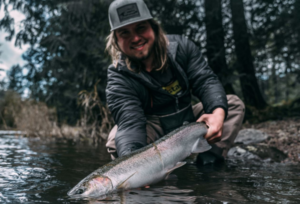
Safely release steelhead
The second field season for the steelhead tagging study being conducted in Idaho has officially started. Tagging at Lower Granite Dam on the Snake River began on July 2, 2020. As of July 19th, 205 steelhead have already been tagged and released as part of this research to evaluate how many wild and hatchery steelhead are caught by anglers, and how often each year.
For the second field season, the goal is to tag a total of 2,000 steelhead; 1,000 adipose-intact fish and 1,000 adipose-clipped fish so obviously we are just getting started with our second season. Anglers will be asked to examine all fish caught for a tag that is located near the dorsal fin. To report a tagged fish, please go to https://idfg.idaho.gov/fish/tag/add. Those who return a tag to Idaho DFG get a reward.
Researchers at the University of Idaho have been taking our first look at the data from the first season of the steelhead study and are learning some interesting things. For additional information on preliminary study results, you can read an article recently published in the Lewiston Tribune.
There are two primary objectives to this study., 1) estimate how many wild steelhead are caught in Idaho’s steelhead fisheries and 2) take a closer look at how well steelhead survive being caught and released. These are important to understand for Idaho’s steelhead fisheries since we manage for both hatchery fish harvest opportunity and wild fish recovery as part of the fishery structure.
Currently, IDFG uses hatchery fish to estimate how many wild fish are caught in the state. IDFG assumes hatchery and wild fish are encountered by anglers at an equal rate. For example, if based on IDFG surveys it is estimated that 40% of hatchery fish were encountered by anglers, then it is assumed that 40% of our wild fish were also encountered by anglers. This study was set up to test if that assumption was accurate.
We tagged 878 wild steelhead at Lower Granite Dam last year. Of the 878 fish, 200 were caught and reported by anglers. However, we recognize that some tags are caught and not reported so it is important to account for non-reporting in our estimates. Since some of the tags had rewards associated with them, we can use that to estimate how many tags were caught and not reported. By combining the tag reports with an estimate of how many tags were caught and not reported, we get an idea of how many wild fish were encountered.
The main findings so far.
In the first year of the study, the encounter rate for Idaho’s wild fish was about 35% while the hatchery fish encounter rate was about 40% to 45%. With wild steelhead conservation being a primary concern for IDFG, this is good news because it means the wild steelhead encounter rate estimated in the past may have been conservative.
To estimate survival of caught-and-released wild fish, we used detections from PIT tag arrays (click here to learn more), fish weirs (click here to learn more), and hatcheries to document survival of our study fish. About 65% of the wild fish reported as caught were detected after capture and known to have survived while about 62% of fish not reported as caught were detected and known to have survived. Preliminarily, the nearly equal rates of detection for fish reported as caught and fish not reported as caught suggest that catch-and-release angling has little influence on steelhead survival.
For more information on Wild salmon and steelhead click here.
Tips to Catch More Trout This Winter
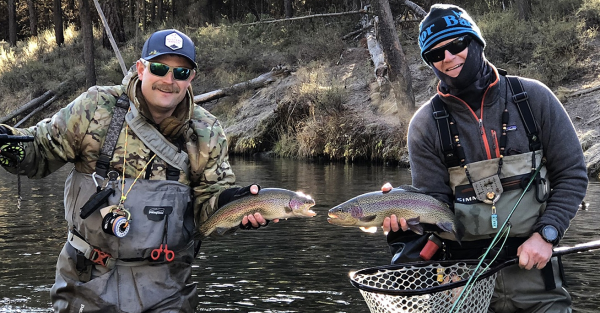 Dedicated fly-anglers don’t stop fishing in the winter. Instead they adjust their tactics to the colder conditions. Dedicated fly-anglers don’t stop fishing in the winter. Instead they adjust their tactics to the colder conditions.Popular trout rivers take on a different character in winter. The barren landscape reveals a different sort of beauty, the crowds diminish and the fishing becomes more challenging. For some, it may be enough “to just be there.” But if your plans include actually catching a fish, here are seven tips that may help improve your chances. 1. Go small and light. Clear, slow water, smaller insects and wary fish call for smaller flies and lighter tippet than you might use the rest of the year.Downsize your flies. A dominate food source for trout in the winter are teeny, tiny midges that are best mimicked by teeny, tiny flies – like size 16 and smaller.Lighten your tippet. If you normally fish 4X, switch to 5X. This will let the smaller flies move more naturally, and avoid spooking fish hanging out in slower waters – where they have more time to scrutinize your fly. 2. Hope for dry fly action but plan to nymph. Winter fly-fishing is a nymphing show. Consider a double-nymph rig with a smaller midge pattern on top and a weighted stonefly below, to help keep your flies near the bottom of the river. But also be prepared for the occasional hatch with a selection of Griffith’s gnats and small blue wing olives. 3. Look for trout in slower waters. Trout metabolism slows in the winter. They’re eating less and looking for ways to conserve energy, like getting out of the heavier currents into quieter waters. Back eddies, off-channel areas, and the inside of current seams can all be places to look for winter trout. 4. Cover the water thoroughly. A fish won’t move far to take a fly (slower metabolism and all that), so you’ll want to put your fly right in front of its nose. Cover the water methodically to increase your changes of hitting a fish. 5. Sleep in. There’s no need to hit the water at daylight when it comes to winter trout fishing. The best fishing will be during the warmest parts of the day – late morning to mid-afternoon. So follow your Mother’s advice and take time to eat a good breakfast before you go. 6. Follow these safety precautions: Travel safely. Travel in the winter can by dicey so be prepared for bad weather and bad roads. Let someone know where you’re going and when you’ll be back. And remember to check in when you get home. Consider using a wading staff. Snow and/or ice can make wading even trickier. And winter is not the time of year you want to be falling in the water. Beware of hypothermia. If you do fall in the water, and it happens, you’ll need to get warm and dry as quickly as possible. Carry a change of dry clothes and hot beverages, or a way to make them. 7. Lower….er, adjust your expectations. Winter trout fishing is about being outside, enjoying the solitude and challenging your fishing skills. It’s not about catching a lot of trout. You’ve got just a few good hours to chase finicky fish – learn to appreciate one- or two-fish days for what they are. Plenty of time to catch loads of fish later in the year. Some of your best bets for catching native redband trout this winter in Oregon include the lower Deschutes, Crooked, Metolius, Fall, Klamath, Blitzen and Owyhee rivers. For the latest fishing updates for these rivers, check out the weekly Recreation Report. From Oregon Department of Fish and Wildlife |
Chattooga River Conservation for Trout
| Text by Greg Lucas Photos by Taylor Main from The Fishing Wire  Watching an experienced team of fisheries biologists and volunteers work with a helicopter pilot to fill and drop brailer bags of trout in a remote river is a little bit like experiencing a ballet — lots of moving parts have to come together with just the right timing to make it all work. Watching an experienced team of fisheries biologists and volunteers work with a helicopter pilot to fill and drop brailer bags of trout in a remote river is a little bit like experiencing a ballet — lots of moving parts have to come together with just the right timing to make it all work.Chattooga, Wild and Scenic River. The very words conjure up all sorts of images. If you have done a bit of whitewater paddling in the region, the Chattooga’s roaring sound pouring over and around boulders is sweet music to your ears. It is one of the longest and most spectacular free-flowing mountain rivers in the Southeast, cascading some 50 miles from its headwaters in North Carolina to the state line between South Carolina and Georgia. But if you are a fly fisherman, or fisherwoman, or, heck, fly ANGLER, then you know the upper reaches of the Chattooga River as something special, particularly in the State of South Carolina, where we are not as blessed with trout waters as our neighboring states of Georgia and North Carolina. For it is a place where an angler can get lost in thought, lost in the music and rhythms of a river that is truly Wild and Scenic, like no other in the Palmetto State. And thanks to an amazing partnership between the South Carolina Department of Natural Resources (SCDNR), the Georgia Department of Natural Resources, the U.S. Forest Service, and Trout Unlimited, large numbers of rainbow, brook and brown trout are stocked in the upper portions of the Chattooga River once a year, a helicopter gently laying them in backcountry areas too remote to easily be reached by vehicle. On Nov. 2, an 11-mile backcountry reach of the Chattooga River was stocked. The Chattooga, which for a good distance forms the border between South Carolina and Georgia, was the United States’ first Wild and Scenic River, designated as such in 1974. The Wild and Scenic designation resulted in the closure of most of the access roads used for trout stocking in this 11-mile section, and that’s the reason the helicopter stocking effort started. The first helicopter trout stockings of this part of the Chattooga began about 50 years ago, and this program has been refined considerably over time. The Chauga River in Oconee was similarly stocked with trout by helicopter on the next day, Nov. 3. “We want trout anglers to have the experience of fishing in this remote and beautiful Wild and Scenic River,” said Dan Rankin, SCDNR Upstate regional fisheries biologist. “But we also want to give them a reasonable chance for success.” The trout fishery in this 11-mile segment of the Chattooga River is largely supported by stocking hatchery trout reared by SCDNR at Walhalla State Fish Hatchery, and by Georgia DNR at Burton State Hatchery. 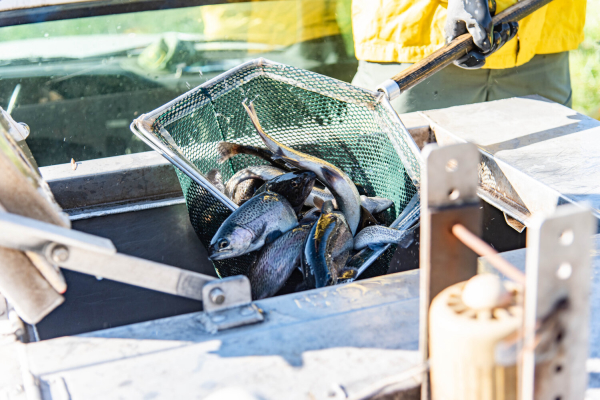 Trout begin their journey in an aerated truck, then are transferred to a helicopter “bucket” for stocking. Trout begin their journey in an aerated truck, then are transferred to a helicopter “bucket” for stocking.These partner agencies and organizations—SCDNR, U.S. Forest Service, Georgia DNR and Trout Unlimited–have worked together as the “Chattooga River Fisheries Coalition” since 1986 to improve the trout fishery. “We are stocking two different ‘management units’ of the Chattooga River by helicopter,” said Rankin. “One two-and-a-half-mile reach is the ‘Delayed Harvest’ area, and the eight-and-a-half-mile upper reach of the ‘Rock Gorge/Big Bend’ area has different regulations from the Delayed Harvest Area.” Delayed Harvest, according to Rankin, is a “fish-for-fun” reach where catch-and-release with single-hook artificial lures is required Nov. 1–May 14 of each year. This stretch reverts to general fishing regulations (5 trout daily limit, no tackle restrictions) from May 15-Oct. 31. The helicopter stocked about 2,500 adult trout (10-plus inches) of rainbow, brown, and brook trout in this section. The Rock Gorge section of the Chattooga River, which is considered a backcountry area, has no tackle restrictions and a 5-trout daily limit year-round. During the Nov. 2 helicopter stocking, SCDNR stocked 15,000 sub-adult (6-inch) brown trout and 1,000 adult brown trout (10-plus inch) in this segment. Georgia DNR will helicopter stock about 10,000 rainbow trout at a later date. “The idea,” Rankin said, “is that some of these smaller brown trout, and then later the rainbow trout from Georgia DNR, will survive next summer and grow out to a nice size for anglers.” Watching the gathering of equipment at Russell Bottoms, alongside SC 28 just before the bridge that leads to Georgia, is quite a spectacle. Dozens of trucks are lined up in a row, with people alternately running helter-skelter around the field (when the helicopter sets down the “Bambi Bucket,” to be filled with trout) and then standing around for long chunks of time while the chopper delivers its load to a remote section of the Chattooga River. Scenes like this are likely the genesis of the phrase “Hurry Up And Wait,” which is so appropriate for any gathering of government employees, whether it be fisheries biologists or infantry soldiers. Completing the scene is that everyone is wearing many articles of Personal Protective Equipment (PPE), which includes a hard hat, eye protection, face coverings/masks, closed-toe shoes (leather boots preferable), gloves, and green and yellow fire-resistant Nomex pants and shirts. The Forest Service is very diligent about PPE, not surprisingly, since being in close proximity to a helicopter is dangerous work. There is zero cell coverage at the site, which makes coordination a real challenge. 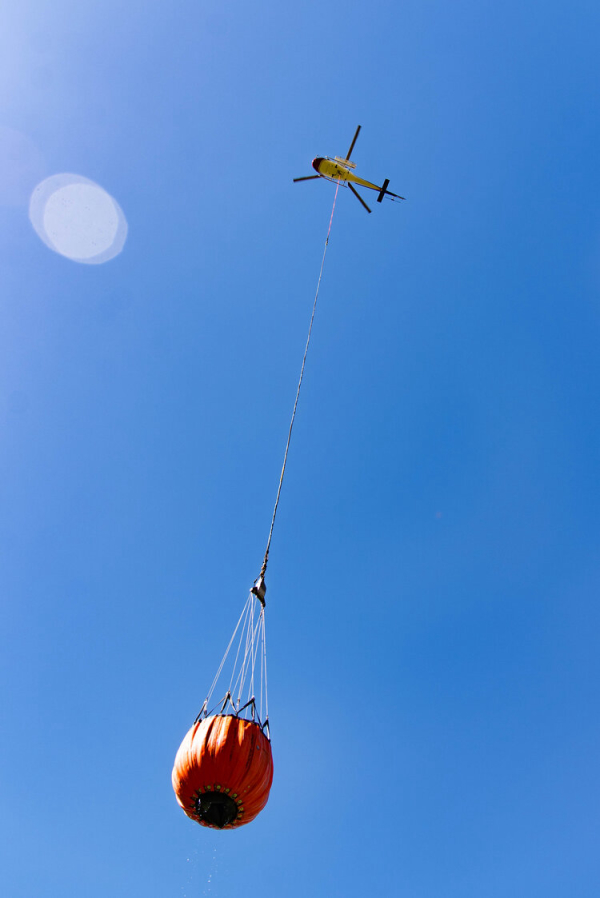 The helicopter makes quick work of ferrying the load of trout to the remote stretches of the river. The helicopter makes quick work of ferrying the load of trout to the remote stretches of the river.The helicopter was already on the scene when SCDNR videographer/photographer Taylor Main and I arrived around 8:20 a.m. Keith Whalen, Forest Service fisheries biologist, got Taylor suited up in all the appropriate PPE, and after the safety briefing (mandatory if you are going to get near the helicopter while the fish are being loaded), Taylor began what would be many hours of photography and videography. Over and over, she captured SCDNR Freshwater Fisheries staff netting trout from the hatchery truck into two 50-gallon plastic buckets, then carrying them to the helicopter’s “Bambi Bucket,” which was at the end of a 150-foot line. The bucket was already “watered,” and SCDNR staff poured the trout into the bucket, the chopper lifted off, and away it went. The trout are bound for the Wild and Scenic Chattooga River, the river that runs through South Carolina and Georgia, and the anglers who will pursue them. |
10 Tips to Catch More Winter Steelhead
| With Robert Bradley, Oregon DFW from the Fishing Wire 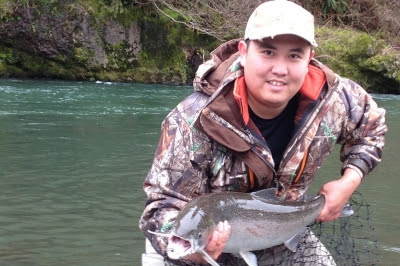 Successful steelhead fishing is more about developing a good strategy for finding fish than about fussing over gear, techniques and colors. (Although pink worms really do work!) When it comes to winter steelhead, it’s easy to get caught up in the minutia of rod types, lure sizes, best colors and latest techniques. But according to Robert Bradley, ODFW district fish biologist in Tillamook, the most important skill to master is knowing where to find fish. (Hint: it’s always near the bottom.) Here are his 10 tips for catching more steelhead by developing a successful fishing strategy and selecting the right gear for current conditions. 1) Do your homework. You can learn a lot about a river, its steelhead runs and current fishing conditions before you even leave home. Figure out the run timing on the river you want to fish. In some places, hatchery fish return earlier in the season – something to think about if you want a fish for the freezer. In rivers with wild broodstock hatchery programs, hatchery steelhead are available over a longer period of time. Wild fish typically arrive later in the run, but these catch-and-release fisheries are often quieter and less crowded, especially in rivers without hatchery programs. Check the current river levels. High water levels put fish on the move but can make fishing more challenging. Often the best fishing is right after a big rain as water levels begin to drop. Find your access points. Bank anglers will want to look for bridge crossings, parks and other public lands. Boat anglers should identify boat put ins/take outs. Make a phone call to the local ODFW fish biologist to get the latest conditions and some fishing tips. Or, visit the weekly Recreation Report. 2) Organize your stuff before you go. Collect and check your boots, waders, clothing, boat accessories, etc.Locate your license and tag. If you’re electronically tagging, remember to log into the MyODFW app before leaving cell phone range.Review the regulations for the waters you want to fish, and check for any in-season regulation updates. You’ll find in-season regulation updates online at the top of each fishing zone in the Recreation Report. Check/replace your mainline, pre-tie your leaders, sort and organize your jigs, spoons and other lures. Remember, you might be wearing gloves, which will make it trickier to pick through your lures.Spend time doing this before you go and you’ll be less stressed once you’re on the water, and have more time for actual fishing. Besides, do you really like tying leaders while standing in 40 degree water during a rainstorm? 3) Join a fishing club or hire a guide. 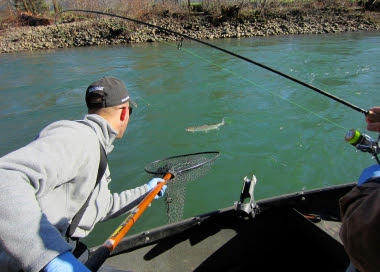 Organizations like the Association of Northwest Steelheaders have several local chapters, and offer a chance to Interact with veteran anglers, see speakers and participate in workshops.You might also consider hiring a guide for a trip on your new home water. A guided trip can be a one-day lesson on how and where to fish a stretch of river. Be sure to let your guide know what you want from the trip — it may be about more than just catching a fish. 4) Pick a “home water.” Spend time learning the water on one river, or even one stretch of a river, rather than jumping from place to place chasing the bite. And we mean really learn the water – explore every nook and cranny with a spinner or bobber/jig to figure out where the fish hold. Also, pay close attention to where other anglers are catching fish. Think about catching more fish in less water. These are transferable skills that, once mastered, can be used on other rivers or streams. One of Robert’s best seasons was when he fished just a single two-mile stretch of river again and again, and where he soon learned every rock that had a fish hiding behind it. 5) Better yet, pick two “home waters.” When water levels rise after a rain, rivers reaches and streams higher in the basin will drop faster and clear first. In the same vein, smaller basins tend to get back in shape faster than larger basins. Just remember the old adage “Water high, fish high. Water low, fish low.” 6) Learn a variety of techniques. But don’t get too complicated. If you’re new to steelhead fishing start with spinner and/or bobber/jig techniques. This gear has some advantages:You won’t lose a lot of gear (helps manage your frustration level), and these are effective techniques to cover the water and locate fish. Drift fishing can be very effective, especially in higher water, but you can lose a lot of gear and spend more time re-rigging than fishing. Be prepared to mix things up based on water or other conditions. 7) Adjust your gear and techniques to water levels. Regardless of the water level, fish will be holding just off the bottom of the river. So no matter what gear you’re using, it’s going to be most effective when it’s near the bottom. Where the fish are. That means you’ll want to adjust your tactics for different water levels so you’re fishing near the bottom without getting hung up all the time. Water levels also will influence where to look for fish and what lines/lures to consider. So, in higher water:Look for fish in the softer waters near the bank or behind obstacles. Upsize your gear. Use a heavier leader* (12-15 pound) and larger weights or lures to keep your gear in the right zone and to handle the increased flows. Consider drift fishing or plunking. These slower presentations can give fish more time to consider your offering. Choose bright colors like orange, bright pink or chartreuse.In lower water: Look for fish further up near the head of holes, or in deeper parts of the runs. Downsize your gear. Use a lighter leader* (8-10 pound) and smaller sized lures or baits. Choose darker, more subdued colors like reds, blues and black.* In general, use a heavier main line and just adjust your leader size for different water conditions. 8) Keep a journal. As you get to know your “home waters” keep notes on recent rains, water levels and temperatures, current weather and conditions, what gear/techniques you used and where/when you caught fish. You may think you’ll remember where you caught a fish, but you probably won’t. You can even take photos of certain hot spots to revisit later. Also, note those places you might want to revisit in the summer, when low summer flows often reveal deeper pools, submerged rocks and other fish holding spots that are harder to see during high winter flows. 9) Assume you’re going to catch a fish. Be prepared to care for the fish you catch and want to keep. Do you know how to properly gill and clean it? Do you have a cooler to keep it in for the drive home? If you’re going harvest the eggs for bait, are you prepared to deal with them when you get home? 10) Know how to safely release a wild fish. 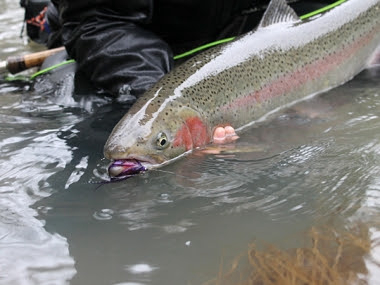 If you’re going to release a fish, do it in a way that gives it the greatest chance of surviving. Land the fish quickly. Use barbless hooks. Keep the fish in the water. Revive the fish before releasing it. Find more information here. Robert Bradley is the ODFW district fish biologist in Tillamook and can be reached at 503-842-2741, ext. 18613 or robert.bradley@state.or.us. |
Habitat Connectivity Helps Trout Take Care of Themselves
Trout Unlimited’s Poose Creek Project in Colorado served as an opportunity to test, validate and perhaps even contribute toward a framework of knowledge around fish passage and habitat connectivity.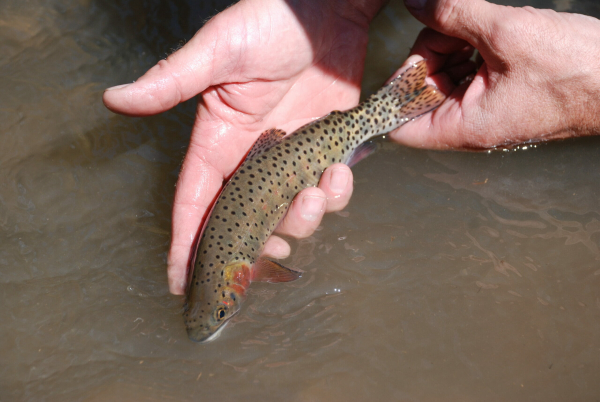 Colorado River cutthroat trout like this one didn’t take long to use a fishway on Poose Creek in Colorado. Colorado River cutthroat trout like this one didn’t take long to use a fishway on Poose Creek in Colorado. Brian Hodge/Trout Unlimited By Brian Hodge, Trout Unlimited from The Fishing Wire In our work at Trout Unlimited, we often rely on scientific theory to plan and implement conservation projects. In some instances, we also test hypotheses by monitoring projects and comparing predictions with outcomes, and in doing so contribute towards the broader body of scientific theory. For TU and our local agency partners, the Poose Creek Project in Colorado served as an opportunity to test, validate and perhaps even contribute toward a framework of knowledge around fish passage and habitat connectivity. When TU and its partners sampled the headwaters of Poose Creek in 2012-2013, native Colorado River cutthroat trout were almost completely absent from the reach above the one road-stream crossing but relatively abundant in the reach below the crossing. 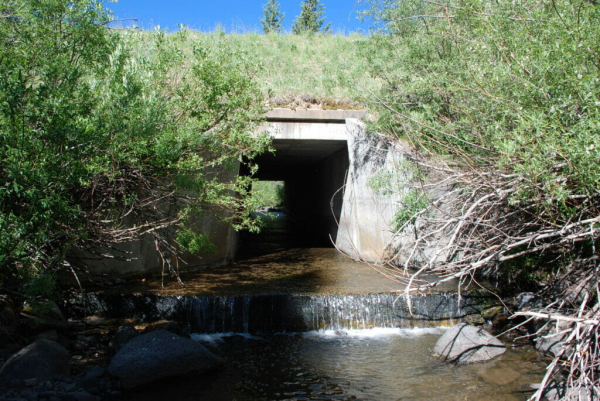 A 108-foot long, concrete culvert and apron were installed at Poose Creek in the 1960s. Brian Hodge photo. Moreover, at long-term monitoring stations upstream and downstream of the culvert, cutthroat densities were 0 and approximately 437 fish per mile, respectively. This contrast confirmed a standing assumption that the box culvert under the road was, and had for decades been, a complete fish passage obstacle. In 2014, TU and the U.S. Forest Service retrofitted the box culvert with a vertical slot fishway, also known as a fish ladder. Although we only designed the fishway to pass adult trout (which are better swimmers and jumpers than their juvenile counterparts), our ultimate goal was to facilitate repatriation by the native cutthroat above the culvert. 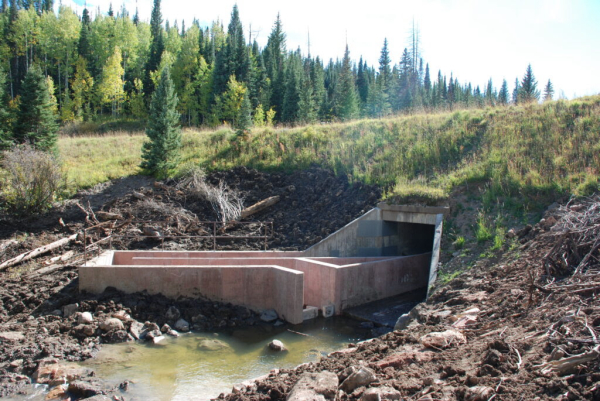 The exiting culvert was retrofitted with a vertical slot fishway in 2014. Brian Hodge photo. The exiting culvert was retrofitted with a vertical slot fishway in 2014. Brian Hodge photo.The fishway project was thus rooted in at least two testable hypotheses: one, that removal or mitigation of the passage obstacle would actually result in fish passage; and two, that the incursion of adult spawners into vacant habitats would result in recolonization by the species (in other words, a few fish would ultimately lead to a lot of fish). Meanwhile, we had much to learn about the effectiveness of fishways for restoring passage to inland (nonanadromous) fish. 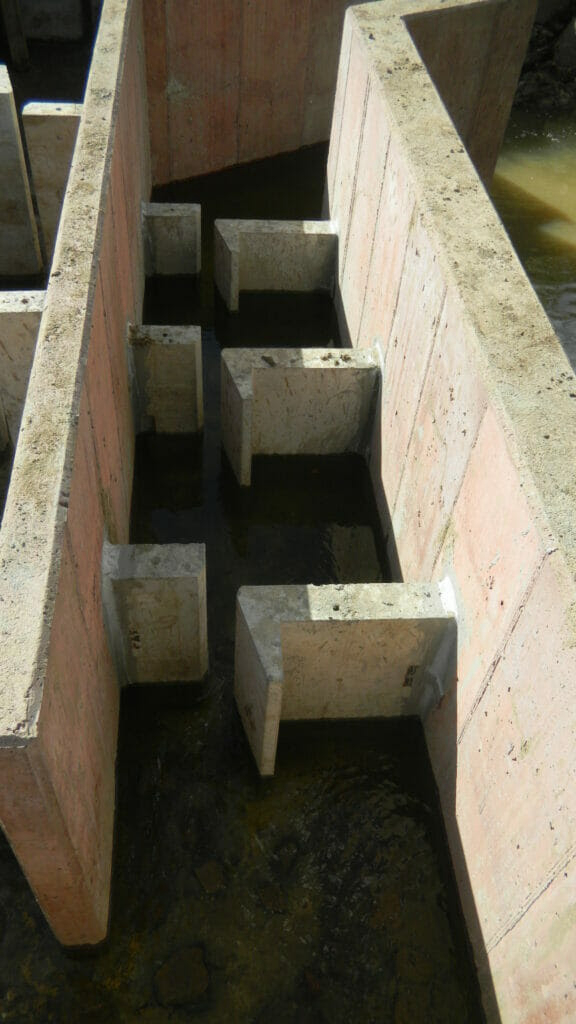 Slotted baffles in the 150-foot long fishway allow fish to swim up the ladder. Brian Hodge photo. Slotted baffles in the 150-foot long fishway allow fish to swim up the ladder. Brian Hodge photo.In 2015 and 2016, we teamed up with Colorado Parks and Wildlife to evaluate the first hypothesis — that the fishway would effectively restore fish passage. We captured cutthroat in the mile of stream below the culvert and injected them with passive integrated transponders, or PIT tags. We then used a series of antennas within and around the fishway to monitor the number of approaches to, attempts at, and successful trips through, the fishway. The result? Cutthroat trout began using the Poose Creek fishway within a year of its construction. In fact, the fishway was completed in fall of 2014 and the inaugural trips through the structure coincided with the spring spawning season of 2015. Approximately 4 percent of all PIT-tagged trout approached the fishway, and 100 percent of the fish that approached it succeeded in entering and passing the new structure. These findings, available here, satisfied our first goal of restoring passage. Nevertheless, questions still remained about the ultimate effect of restoring connectivity. 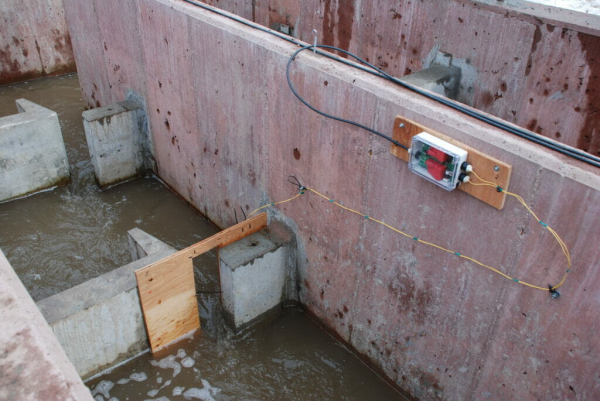 One of four stationary antennas installed in and around the fishway. Brian Hodge/Trout Unlimited One of four stationary antennas installed in and around the fishway. Brian Hodge/Trout UnlimitedIn fall of 2020, approximately one and a half to two cutthroat trout generations after the fishway was installed, we tested the second hypothesis— that restoring fish passage would lead to recolonization of upstream habitats. Specifically, we used backpack electrofishing units to survey a half-mile segment of stream immediately above the culvert, and to repeat a multiple-pass population estimate at the long-term monitoring site (located approximately 0.6 miles upstream of the culvert). In 2012, the segment of the stream was vacant of cutthroat trout. In 2020, the same segment hosted at least 589 cutthroats. Similarly, the same long-term monitoring station that contained cutthroat at a density of 0 fish per mile in 2012 contained cutthroat at a density of approximately 2,752 fish per mile in 2020 (817 fish per mile excluding the 2020 year-class). Just as importantly, the presence of multiple age classes, and of young-of-year fish in particular, confirmed that Colorado River cutthroat trout were spawning in and recruiting to the headwaters of Poose Creek. Of course, we can’t rigorously measure the percentage increase in cutthroat abundance above the fishway because the native salmonid was absent from the long-term monitoring site in 2012. Yet, even without the numbers, we might all recognize the indicator of success. 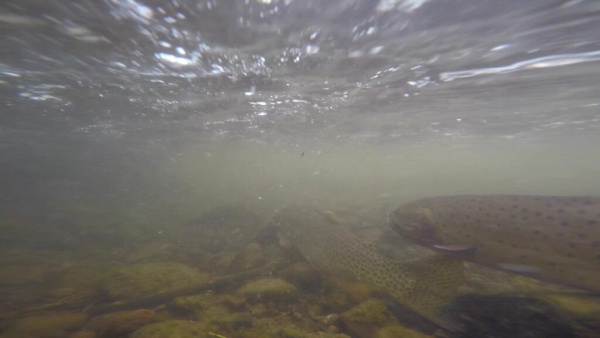 Colorado River cutthroat trout make their way to spawning grounds. Brian Hodge/Trout Unlimited Colorado River cutthroat trout make their way to spawning grounds. Brian Hodge/Trout UnlimitedIn the end, our findings at Poose Creek offered support of theory:If we do our part to remove migration obstacles from rivers and streams, the fish will take care of the rest. The benefits could be immeasurable. Brian Hodge is the Northwest Colorado Director for Trout Unlimited’s Western Water and Habitat program. |
Restoration Brings Salmon, Anglers Back to California’s Clear Creek
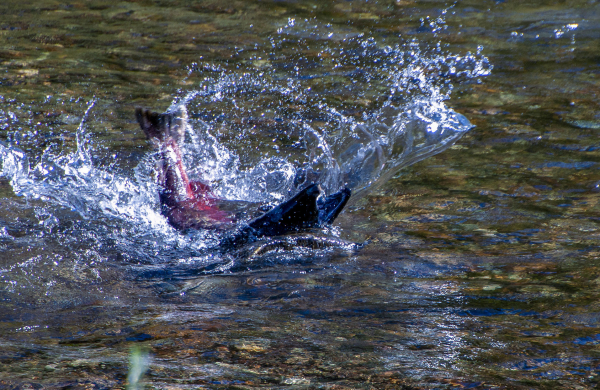 A male Chinook salmon, with red coloration, strikes another male Chinook on Clear Creek in Redding, California, during spawning season in October. Credit: Brandon Honig/USFWS By Brandon Honig, USF&W A male Chinook salmon, with red coloration, strikes another male Chinook on Clear Creek in Redding, California, during spawning season in October. Credit: Brandon Honig/USFWS By Brandon Honig, USF&WClear Creek has been transformed multiple times in the past two centuries, but the transformation of the past few decades was designed to last. Ravaged first by gold-seekers and then by gravel-miners, the Sacramento River tributary is today a haven for fish and people alike.“You get to see big male salmon chasing each other away from females and see females digging redds, or nests. It’s exciting,” said U.S. Fish and Wildlife Service biologist Charlie Chamberlain. “It’s something a lot of people would not expect to see in California except on National Geographic.” 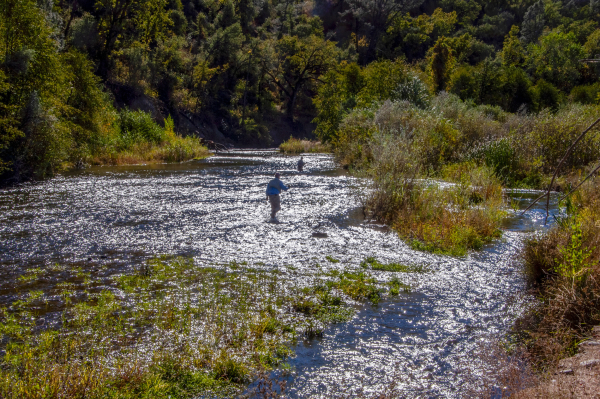 Local fishermen search for steelhead in Clear Creek, where restoration has created diverse conditions and habitats for fish. Credit: Brandon Honig/USFWS Local fishermen search for steelhead in Clear Creek, where restoration has created diverse conditions and habitats for fish. Credit: Brandon Honig/USFWSThirty years ago, it wasn’t something you’d see in Clear Creek either. There was little water flowing, and Saeltzer Dam closed off more than 11 miles of potential habitat for sensitive species like Central Valley steelhead and spring-run Chinook salmon. The Bureau of Land Management, however, acquired most of the Lower Clear Creek channel bottom in a series of deals in the 1990s. At the time, the creek was mainly known as an out-of-the-way place for illegal trash dumping and suspicious activity. “Some smart people at BLM understood Clear Creek’s potential for restoration, and they got a good deal on it because it was an industrial wasteland,” said biologist Derek Rupert, who oversaw the final phase of the project for the Bureau of Reclamation. “They made some good choices, so now the public owns the majority of this land.” Planning a partnership In 1992, Congress passed a massive fish and wildlife restoration program for California, the Central Valley Project Improvement Act. Among other measures, it singled out Clear Creek for an overhaul to be funded jointly with the state. The planning process involved a large group of landowners, stakeholders, consultants and agency experts, which delivered a multi-pronged approach. The plan would reconfigure part of the creek channel, raise the water level, open up areas for fish habitat and increase the stream’s complexity and food production. “My hat’s really off to those people who were involved in the late 1990s,” said Tricia Bratcher, a habitat restoration coordinator for the California Department of Fish and Wildlife, who joined the Clear Creek Technical Team in 2001. “They really put in some good thought on what restoration should look like, how it would function and the goals associated with all of that.” Before the work began, she said, Clear Creek looked “trashed.” There were pits and piles of dredger tailings everywhere, and the water was shallow and warm, with virtually no riparian vegetation. Reports of people lurking there also kept locals away. To clear the way for the restoration program, the Shasta County Sheriff’s Office teamed with the state and BLM rangers to tighten security and clean up Clear Creek. As the restoration work progressed, residents saw trails, restrooms and parking lots installed. “Now when we go out there, there are families utilizing the area, swimming with kids, fishing, mountain biking, hiking with dogs,” Chamberlain said. “That greenway vision BLM had is being realized.” A food-based explosion Restoration began by increasing water flows through Reclamation’s Whiskeytown Dam, then removing the privately-owned Saeltzer Dam. Those steps brought fish to Clear Creek in the thousands, but the stream was nothing like its former self. 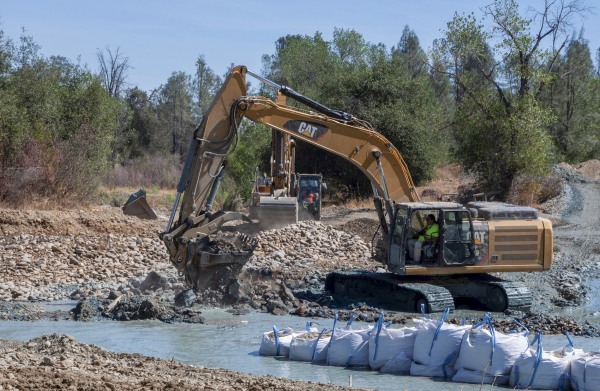 Workers plug a ditch dug by gravel-miners last century and redirect its water into a new channel on Clear Creek’s original path. Credit: Brandon Honig/USFWS Workers plug a ditch dug by gravel-miners last century and redirect its water into a new channel on Clear Creek’s original path. Credit: Brandon Honig/USFWS“Miners basically dug a ditch here along the valley and diverted the creek into it so they would have room for gravel extraction,” Chamberlain said of one part of the restoration area. “They took a creek that used to have this dynamism to it and serve a lot of ecological functions, then dumped it into a little chute where it had very little ecological function and no dynamism. ”Creeks are naturally complex. They change speed and direction, pull in branches and move sediment. That action creates gravel bars, riffles and side channels, which foster plant and insect growth. The channel the gravel-miners dug, on the other hand, was like a swiftly moving canal that only eroded downward. It didn’t change over time, and it didn’t create much habitat. The restoration plan called for filling in the miners’ ditch and restoring the creek’s original path. It also required lowering the floodplain to create longer-lasting habitats and nourishment for rearing fish. “If you change the shape of the creek so it spreads out and trickles into the floodplain or side channels, you get extra-slow areas where you’ve wet new surfaces, and those floodplains generate a lot of fish food and grow vegetation,” Chamberlain said. “You get a food-based explosion.” Workers have placed downed trees and more than 180,000 tons of gravel in Clear Creek since the 1990s to help create habitat. Salmon spawning habitat was the original focus, but the work has created diverse conditions that benefit fish in multiple life stages. The latest phase focused on juvenile salmon, but will also provide homes for beavers, song sparrows and pond turtles. “For juvenile fish, woody debris provides refuges from predators and spots to hold and wait for food to float, swim or fly by,” said Matt Brown, who managed the Fish and Wildlife Service’s program on Clear Creek from 1995-2017. “There will also be areas for adult fish to hang out and rest before they spawn and other areas with good spawning habitat.” A long-term commitment The 2.2-mile Lower Clear Creek Floodway Rehabilitation Project took more than two decades to complete. Along the way, the multi-agency Technical Team overcame challenge after challenge, culminating in completion of the final stage in October. “I’m proud of the work that came before me and the perseverance they showed,” said Chamberlain, who has worked on the project since 2015. “People aren’t always resilient enough to insist that, ‘there’s a great opportunity here,’ even when the naysayers can’t see it. A vision was implemented here, and it’s working.”  A Chinook salmon swims in Clear Creek during spawning season in October. Restoration work that began in the 1990s has turned Clear Creek into a salmon-producing hotspot. Credit: Brandon Honig/USFWS A Chinook salmon swims in Clear Creek during spawning season in October. Restoration work that began in the 1990s has turned Clear Creek into a salmon-producing hotspot. Credit: Brandon Honig/USFWSIn addition to the Service, Reclamation and the state, the project received significant contributions from National Oceanic and Atmospheric Administration Fisheries, the National Park Service, California Department of Water Resources, the Yurok Tribe and a variety of local organizations including the Western Shasta Resource Conservation District. The experience often felt like a marriage, Bratcher said. “Sometimes it drives you crazy, but you love the place, so you work through the problems and will be stronger for it,” she said. “We’ve had some really good people, some really knowledgeable people, who have continued to stick it out and really love Clear Creek.”Also like a marriage, she said, the commitment to Clear Creek should be eternal.“I’d hate for people to say, ‘We’re done on Clear Creek,’” Bratcher said. “Any time you implement a change, it disrupts the patterns and you have a responsibility. You are beholden to watch over it and be a steward.” 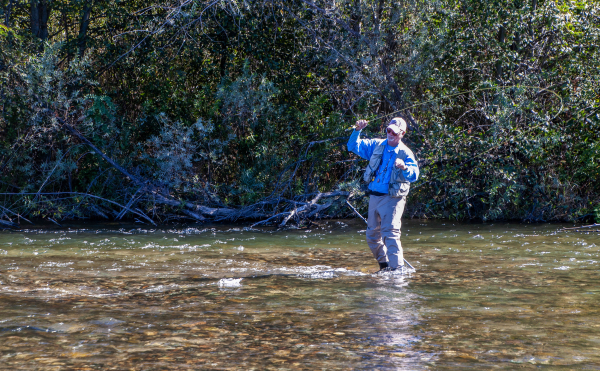 Creighton Smith of Redding tries to pull a steelhead out of Clear Creek in October. Wild steelhead must be released unharmed when caught in California. Credit: Brandon Honig/USFWS Creighton Smith of Redding tries to pull a steelhead out of Clear Creek in October. Wild steelhead must be released unharmed when caught in California. Credit: Brandon Honig/USFWS |
Record Lake Champlain Lake Trout a Testament to Successful Sea Lamprey Control
The jumbo trout had no sea lamprey scarring despite a long life in a lake once heavily infested–lamprey control efforts have clearly been effective.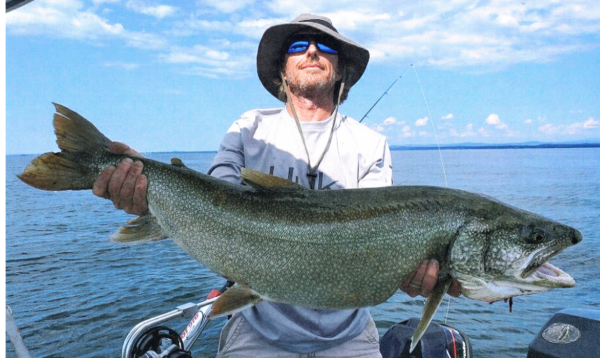 By John Hall, Vermont Fish & Wildlife Department By John Hall, Vermont Fish & Wildlife Departmentfrom The Fishing Wire The Vermont Fish and Wildlife Department recently certified a record fish entry for a 19.36-pound lake trout caught in Lake Champlain in August. Department officials say this demonstrates the positive impact long-term sea lamprey control efforts are having on the lake’s quality fishing opportunities. Angler Jeffery Sanford, of South Burlington was fishing alone the day he jigged up the 36.5-inch lake trout from over 100-feet of water. “I just got my first boat this year, and it was my first time out alone,” recounted Sanford. “It hit on my first cast of the day. Once I netted it and got it in the boat I was astounded at its size and lack of any lamprey scars or wounds.” Sanford said he wanted to release the lake trout alive but was unable to revive the fish, so he brought it in to be weighed officially as part of Lake Champlain International’s Basin Derby, and he also entered it into the Fish and Wildlife Department’s record fish program. The fish currently sits in first place for the derby’s lake trout category. According to department fisheries biologist Shawn Good, who oversees the Vermont State Record Fish Program, Sanford’s catch is a reason for celebration. “Jeff’s fish is the largest lake trout from Lake Champlain entered in the Record Fish Program since the department started keeping fish records in 1969,” said Good. “There have been much larger lake trout caught in other Vermont waters, but this Champlain fish is a big deal.” According to Good, it is a direct result of good lake trout habitat in Lake Champlain and ongoing sea lamprey control efforts. In Lake Champlain, nuisance sea lamprey prey on lake trout, landlocked Atlantic salmon, brown trout, steelhead, walleye, lake sturgeon, and other fish species. High attack rates and sea lamprey wounds can result in lower growth, smaller size, shortened life expectancy, and decreased fishing opportunities. To counter this, the Lake Champlain Fish and Wildlife Management Cooperative, comprised of the Vermont Fish and Wildlife Department, the New York Department of Environmental Conservation, and the U.S. Fish and Wildlife Service, initiated an experimental sea lamprey control program in 1990. A long-term control program that began in 2002 continues today. Sanford’s observation of no sea lamprey wounds on his record catch is significant, says Good. “We’re seeing lower overall wounding rates on many of these fish, and the fact that anglers are catching older, larger lake trout, salmon, and other fish species is proof that continued long-term sea lamprey control is working, and resulting in improved fishing opportunities on Champlain.” Elizabeth Ehlers, Tournament Director of the LCI Fishing Derbies, says the annual Father’s Day Derby and year-long Basin Derby have seen bigger and bigger fish in recent years. “There’s been an upward trend in size for many of the species entered in our derbies. Over the past 10 years, we have seen several record-breaking fish in cold, cool and warm water species divisions.” “While our anglers are incredibly dedicated and skilled, these catches are not just by chance or luck. The Vermont Fish and Wildlife Department has worked tirelessly to protect and restore the Lake Champlain fishery. Their management efforts – including lamprey treatment, control of invasive species, and fish stocking – have benefited all who enjoy this resource. The impact of their efforts extends far beyond the angling community, as Lake Champlain anglers contribute over $200 million dollars annually to local economies.” Jeff Sanford says he’s grateful for the fishery that continues to improve on Lake Champlain. “It was an amazing fish and quite the battle. I’m extremely excited for next season! We have such an incredible fishery here.” Sanford says he credits the openness of other anglers in the lake’s fishing community with helping him catch the lake trout and becoming a better angler. “I just learned how to jig for lake trout this year from friends like Will Nolan, Ryan Carpentier and Jamie Shiekone. They provided the mentorship and tutelage I needed to learn a new technique. Everyone’s so open and friendly, and willing to help you learn something new.” Good says that is heartening to hear. “To maintain and grow participation in the sport we all love, it takes a village. I’ve always encouraged avid anglers to take newcomers out and show them the ropes. It can be challenging for a new angler to learn techniques that will help them be successful. I hope more anglers step up and become mentors to friends, family, even strangers.” This fall, the Lake Champlain Fish and Wildlife Management Cooperative is conducting sea lamprey control treatments on four Vermont rivers containing spawning populations of sea lamprey. The Winooski River was treated on October 2, the LaPlatte River will be treated on October 14 or 15, and control treatments will take place on the Lamoille and Missisquoi rivers within the next month. To learn more about Lake Champlain’s sea lamprey control program, visit: https://www.fws.gov/champlainlamprey |